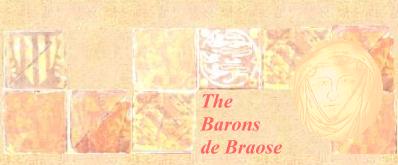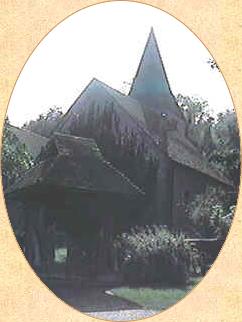
Scoundrels
 Law
suits over land and money continued throughout William's life.
His debts soared when Simon de Montfort attempted to ruin him.
As a committed royalist, William had fought against the de Montforts
and devastated Simon de Monfort junior's manor of Sedgewick (which
was in the rape of Bramber). In the months after his victory
at the battle of Lewes, Simon de Montfort set his sights on revenge
as well as personal expansion in Sussex.
Law
suits over land and money continued throughout William's life.
His debts soared when Simon de Montfort attempted to ruin him.
As a committed royalist, William had fought against the de Montforts
and devastated Simon de Monfort junior's manor of Sedgewick (which
was in the rape of Bramber). In the months after his victory
at the battle of Lewes, Simon de Montfort set his sights on revenge
as well as personal expansion in Sussex.
William de Braose failed
to appear at the Tower of London when a de Montfort "court"
summoned him to hear the charges. On June 30, 1264 damages
were awarded against William for the outrageous sum of ten thousand
marks. In addition, his son and heir and his castle at
Knepp, already seized by Simon de Montfort, would be held until
arrangements for payment were made. The young William de Braose
(23.1) was held by Eleanor de Montfort,
first at Odiham castle in Hampshire, then at Dover castle, until
her husband's defeat at the battle of Evesham in 1265.
In 1278 William's port of Shoreham was protesting to the king about
their lord's extortionate methods of raising revenue and abuses
of custom duties. He was accused of taking "from every
ship one cask before the mast and one behind and likewise took
prise of wax and other merchandise against the will of the merchants
and in the king's despite". William denied the charge but
his financial affairs had become a source of scandal and earned
him a scoundrel's reputation.
 A
Swansea historian (W H Jones) is quoted in the Oystermouth castle
guidebook, referring to the de Braose lords of Gower: "The
de Braoses were a licentious clan of freebooters, who appear
to have been so habituated to duplicity and chicanery as to render
it impossible to be straightforward and honest in their dealings
with their neighbours".
A
Swansea historian (W H Jones) is quoted in the Oystermouth castle
guidebook, referring to the de Braose lords of Gower: "The
de Braoses were a licentious clan of freebooters, who appear
to have been so habituated to duplicity and chicanery as to render
it impossible to be straightforward and honest in their dealings
with their neighbours".
William died on January
6, 1291 at Findon, Sussex and he was buried at Sele
priory. His oldest son William had already taken on many
of the duties of the lordship and the inheritance was granted
by the king on March 1, 1291.
True to his father's tradition,
young William had law suits that had been rumbling on for years.
In 1299 the Bishop of Llandaff succeeded in a plea to the king,
who ordered William to answer for his misdeeds before the court
and the royal justices. In 1306 William's tenants in Gower sought
justice from the king, having taken the drastic step of deserting
their lands. They accused their lord of failing to protect them
and their rights. His neglect and mismanagement had disgraced
the marcher lordships. William was forced to issue charters of
rights for the burgesses of Swansea and his tenants in Gower.
Another case reached boiling
point in 1307. William was ordered in court to give eight hundred
marks to his father's third wife and widow, Mary de Roos. William
mounted the bar in fury and bitterly insulted the judge. The
king ordered him to walk from Westminster to the exchequer without
his sword belt and with his head uncovered, to seek the judge's
pardon. He was then put in the Tower of London for contempt of
court. William was all but bankrupt and forced to sell his lands
to pay his debts.

back
to text

back to text
William de Braose failed to appear at the Tower of London when a de Montfort "court" summoned him to hear the charges. On June 30, 1264 damages were awarded against William for the outrageous sum of ten thousand marks. In addition, his son and heir and his castle at Knepp, already seized by Simon de Montfort, would be held until arrangements for payment were made. The young William de Braose (23.1) was held by Eleanor de Montfort, first at Odiham castle in Hampshire, then at Dover castle, until her husband's defeat at the battle of Evesham in 1265. In 1278 William's port of Shoreham was protesting to the king about their lord's extortionate methods of raising revenue and abuses of custom duties. He was accused of taking "from every ship one cask before the mast and one behind and likewise took prise of wax and other merchandise against the will of the merchants and in the king's despite". William denied the charge but his financial affairs had become a source of scandal and earned him a scoundrel's reputation.
William died on January 6, 1291 at Findon, Sussex and he was buried at Sele priory. His oldest son William had already taken on many of the duties of the lordship and the inheritance was granted by the king on March 1, 1291. True to his father's tradition, young William had law suits that had been rumbling on for years. In 1299 the Bishop of Llandaff succeeded in a plea to the king, who ordered William to answer for his misdeeds before the court and the royal justices. In 1306 William's tenants in Gower sought justice from the king, having taken the drastic step of deserting their lands. They accused their lord of failing to protect them and their rights. His neglect and mismanagement had disgraced the marcher lordships. William was forced to issue charters of rights for the burgesses of Swansea and his tenants in Gower. Another case reached boiling
point in 1307. William was ordered in court to give eight hundred
marks to his father's third wife and widow, Mary de Roos. William
mounted the bar in fury and bitterly insulted the judge. The
king ordered him to walk from Westminster to the exchequer without
his sword belt and with his head uncovered, to seek the judge's
pardon. He was then put in the Tower of London for contempt of
court. William was all but bankrupt and forced to sell his lands
to pay his debts.
|
||||